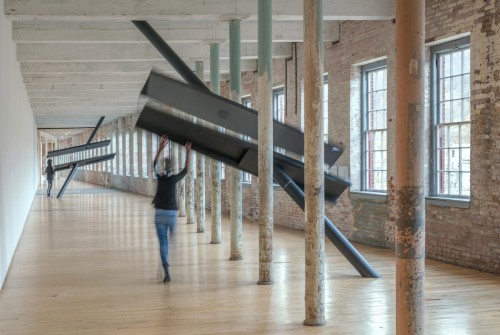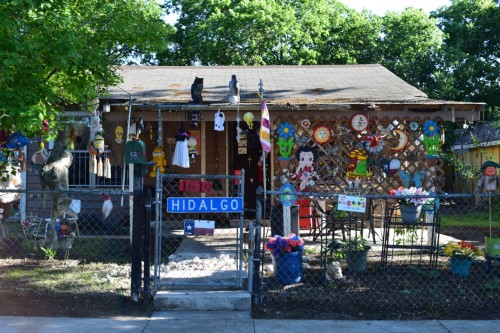When we design with the land and the myriad stewards that call it home in mind, we open the door to building with things that often go unseen.

In Brooklyn winters, sunset can start as early as 4 p.m. The sky is gray, the windchill is biting, and the city is covered in a crusty film of salt. Even in this season of darkness (and in the now-tempting light of spring), dozens of neighbors have been gathering every Sunday afternoon in a local bar to plant the seeds for how they might build a forest garden in the Central Brooklyn neighborhood of Crown Heights.
I founded this group, an artist collective called Field Meridians, and have guided its plans since 2022. We develop tools for ecological resilience in the form of artist-facilitated programming, publishing, and radio broadcasts. We don’t have money. We don’t have land. We come together to practice a form of “life in rehearsal”—a call to action conceptualized by abolitionist geographer Ruth Wilson Gilmore. We collectively envision a relational architecture for our community.
Relational architecture is a living, multispecies assemblage designed to foment, support, and nurture relationships built on communal solidarity. A forest garden is one shape of relational architecture. Its biodiverse plantings of crops mimic natural forests: functional ecological niches within niches that adapt to their space and time. Before colonization, much of the northeast coast of Turtle Island (how some Indigenous American people refer to North America) was a thriving forest garden stewarded with the aid of Indigenous sciences. British horticulturist Robert Hart popularized the term forest garden in the 1980s; today’s permaculture practice uses the term food forest.
Field Meridians sees its food forest as a place that will provide healing and repair. Once it takes root, it will be a living classroom in which we can tune in to the seasons, learn about ecologies, and be in a more conscientious relationship with our food. It can be a model for food sovereignty in New York, which we strongly believe in: Every community has a right to healthful and culturally appropriate food produced through ecologically sound and sustainable methods, and the right to define its own food and agricultural systems. The process of planting it invites our neighbors to build a pathway for us to imagine and make something together.
Our definition of relational is informed by the work of feminist and posthuman philosopher Donna Haraway, especially her foundational theory of entanglement, which argues that human and more-than-human worlds are interconnected through networks and within ourselves. It’s also informed by the Not Lone Wolf initiative, a group of geographers working toward collaborative relational research practices—and the work of trawlwulwuy geographer Lauren Tynan in particular, who reminds us that “relationality is not a new metaphor to be reaped for academic gain, but a practice bound with responsibilities with kin and Country.”
We look to write design into current social-ecological movements as a part of a long continuum of community-driven projects in Crown Heights, which includes late-1960s early childhood educational programs; neighbors taking over disused lots to create community gardens in the 1980s; and the drive, helmed by Black female matriarchs, to landmark our community, in the 2000s. We value such assemblages for their ability to create and maintain connections among the animate and inanimate, humans and the more-than-human, objects and environments.
Relational is also informed by the decade-long work of MOLD, the magazine I founded about designing the future of food. By being in relationship with our food—knowing where it comes from, who grows it and how, in which season it is at the height of its deliciousness and why it happens then—we are in relationship with entire living ecologies. Over the past year, MOLD has published a series on relational architectures detailing some of the ways that organizations are using design to generate tools for fostering greater resilience in the face of planetary crisis: from revisiting the history of a radical immigrant community print press to considering fire as a tool for design.
In a time marked by great uncertainty and despair, when the divisive forces of oppression can feel insurmountable, Field Meridians is rooting into the land and knitting together community. It is a hedge against the overwhelming sense of powerlessness. It is also a reminder that we are working on tree time, a timescale that exists outside of human deadlines. It is humbling to remember that I might plant a tree that I will never taste the fruit of. My only hope is that my work and my stewardship will allow my children to relish its future abundance.
When we design with the land and the myriad stewards that call it home in mind, we become collaborators with the more-than-human and open the door to building with things that remain unseen. By prioritizing care and relational frameworks in the design and construction of the places we live in, we invite a radical shift in scale and the composition of our material environments.
This requires a different set of questions and an expansive perspective that stands in stark contrast to the questions being asked of architects today. What does it mean to have a block-by-block strategy? How can we build to accommodate tree time? How do we learn to read what the land wants and can provide? What does it mean to be resilient in a time of extreme climate emergency? Can designers be facilitators of a new kind of world-building?
This spring, Field Meridians will begin to share its work with a wider circle of neighbors, including the local community board, council members, block associations, community gardens, and other leadership. Our hope is that this proposal will spark conversation and collaboration: We all have foods that remind us of home and safety; we all have a stake in this work.





